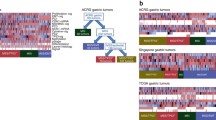Abstract
Invasion and metastasis are critical determinants of cancer morbidity. Genes and molecules participating in these steps must be regarded as potential prognostic factors. Growth factors and their receptors, cell-cycle regulators, cell-adhesion molecules and matrix-degrading enzymes are those to be used as prognostic factors, including epidermal growth factor (EGF), EGF receptor, K-sam, HER-2, interleukin (IL)-8, vascular endothelial growth factor (VEGF), cyclin E, p27, E-cadherin, CD44v6, matrix metalloproteinase-1 (MMP-1), and tissue inhibitor of matrix metalloproteinase-1 (TIMP-1). Alterations in epigenetics, such as aberrant DNA methylation and histone modification that are, in part, associated with the tumor progression of gastric cancer, can be candidate prognostic factors. The number of methylated genes may serve as a marker of tumor progression. Genetic polymorphism not only affects cancer susceptibility but also influences malignant phenotype; examples include single-nucleotide polymorphism in the HER-2 and MMP-9 genes. Comprehensive gene expression analyses are useful to search for novel genes related to invasion and metastasis and potential prognostic factors. Serial analysis of gene expression (SAGE) has identified several these genes, such as CDH17, APOE, FUS, COL1A1, COL1A2, GW112, and MIA. Overexpression of MIA is found to be associated with poor prognosis. Microarray analysis has great potential for identifying the characteristics of individual cancers, from the view point of gene expression profiles. A combination of these examinations can not only foretell a patient’s prognosis but can also give information directly connected with personalized cancer medicine and prevention.
Article PDF
Similar content being viewed by others
Avoid common mistakes on your manuscript.
Author information
Authors and Affiliations
Rights and permissions
About this article
Cite this article
Yasui, W., Oue, N., Aung, P. et al. Molecular-pathological prognostic factors of gastric cancer: a review. Gastric Cancer 8, 86–94 (2005). https://doi.org/10.1007/s10120-005-0320-0
Received:
Accepted:
Issue Date:
DOI: https://doi.org/10.1007/s10120-005-0320-0




